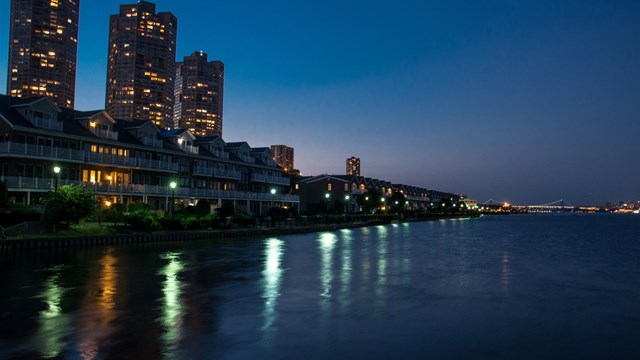It’sbeen a difficult year for the real estate market in New Jersey. By most accounts, the economy nationwide is improving, and the recession is fading. However, a year after Superstorm Sandy, many communities in New Jersey are still struggling to come back. Municipalities, county governments and departments with municipal and state governments still prominently feature items about Sandy repair on their websites. The storm affected the condo and HOA market as much as it did the overall real estate market.
Sandy, which hit the area in October of 2012, was the type of storm that people (hopefully) will see only once in a lifetime. Large numbers of houses along the shore were destroyed, and storm-surge water destroyed basements and ground floors of homes in towns like Hoboken and Jersey City as well.
Oh, Sandy!
A report from Rutgers’ Edward J. Bloustein School of Planning and Public Policy, “The Economic and Fiscal Impacts of Hurricane Sandy in New Jersey,” details some of the losses. All in all, there was a loss of $9.72 billion over a three-week period during the last quarter of 2012. There was also a loss of approximately $82 million in state tax revenue for the third quarter of 2012. In addition, there was a net loss of 4,200 jobs in the state during the same period.
Paradoxically, however, the aftermath of the storm has given rise to a frenzy of construction and real estate activity that is expected to spark other areas of the economy. The Rutgers report, written in early 2013, says, “Construction industries and related service industries (e.g. engineering, design, real estate and finance) will benefit broadly.” All in all, says the report, about $25.1 billion in recovery expenditures was expected.
This dynamic was at play within a few months after the storm. “Prior to the hurricane,” says James Tortorelli, branch vice president of Coldwell Banker Residential Brokerage in Jersey City, “most of New Jersey experienced double-digit monthly gains in contract sales during 2012. Following Superstorm Sandy, most of the state dropped to single-digit gains in contract sales for November and December of 2012. Then, January 2013 saw a nice increase again of 23 percent,” he says, referencing data reported by Jeffrey Otteau of the Otteau Valuation Group in East Brunswick.
The New Jersey Association of Realtors’ (NJAR) monthly report of December 2013 also bears out some of the Rutgers study’s predictions. In the “townhouse-condo market,” according to the report, pending sales were up 2.7 percent over the previous December, closed sales were up 11.8 percent, median sales prices were up 7.1 percent, and average sales prices were up 8 percent. When year-to-date values from 2013 are compared to those from 2012, the increases are even more marked, in some cases exceeding 20 percent.
Ocean County is one of the areas that was heavily hit by the storm (which is referred to as both Hurricane Sandy and Superstorm Sandy, depending on who you’re talking to). It includes such exposed areas as Long Beach Island, Seaside Park and Toms River. Adam Reynolds of ERA Byrne Realty, president of the Ocean County Board of Realtors, said that on the whole, HOAs and retirement homes were mainly in the upland areas and didn’t sustain serious damages.
The areas hard-hit by the storm, however, contained many condos, which are being rebuilt. Sales of townhouses and condos are up 14 percent over the past year, he notes. “Prices are up, but inventory is not.”
Kenneth Nilson, a broker at RE/MAX at Barnegat Bay, says that many of those retirees who were living on the shore and whose homes were damaged “have purchased homes in the upland areas that have created a shortage of homes for sale, especially in Ocean County.” He adds that the shore-area homes, including condos, were basically people’s “secondary residences,” or second homes, but homes in the upland areas are mainly used as “primary residences.”
The upturn has also been seen in the state’s northern areas. Tortorelli quotes The Jersey Journal to the effect that Jersey City/Hoboken waterfront condo sales in November 2012 were up 36 percent compared to 2010.
“Reasons for this growth include low inventory on the Hudson waterfront and skyrocketing Manhattan prices driving buyers to look immediately outside the city,” says Tortorelli. “Pent-up demand from buyers, who hesitated during the few years previous, made multi-offer situations commonplace again in 2013.”
At least one observer, however, also calls attention to the problems that existed before Sandy, not only those caused by the storm. “New Jersey’s condominiums are plagued with abandoned units, delinquent owners, etc., now, in what appears to be similar to how they were plagued before the storm,” says attorney David Byrne, a partner in Herrick, Feinstein LLP’s Community Associations Group, which has offices in both Princeton and New York City. “I will say that some of my clients, who had the wisdom to seek to place abandoned units into receivership, per my advice, benefited as a result of Sandy, as there were many more New Jersey residents looking for quickly-turned-around temporary housing.”
Looking Forward
We know what happened in the past, but what do professionals think will happen in the New Jersey real estate market, including co-ops and condos, in the next year or so?
The Rutgers report predicts that recovery expenses will bottom out toward the end of 2014 and remain flat in 2015, creating a respite for homeowners and businesses. The report also forecasts that “the largest employment increase will occur in 2014,” and the “ripple effect” ensures that this dynamic will be felt in other sectors of the economy—including real estate.
Nilson of RE/MAX predicts that “prices will keep pace with overall price appreciation. We will expect home appreciation rates ranging from 1 to 3 percent increases in 2014.”
While everyone agrees that the economy as a whole has been steadily improving, is the “Great Recession” over? Clearly, the days of high-profile business failures—Lehman Brothers, Washington Mutual, General Motors, Countrywide, Bear Stearns—are behind us. And the Bureau of Labor Statistics reported that starting in 2010, more jobs have been created than have been lost.
Even so, the New Jersey unemployment rate in November 2013, according to online statistics, was 7.8 percent, significantly higher than slightly over 4 percent in 2007, just before the recession.
One positive sign, at least in New Jersey, is the decline in the number of “underwater mortgages,” in which homeowners owe more money than the value of the home itself. NJAR, in its online market reports, notes that “the share of mortgaged homeowners underwater in New Jersey is below the national average.” The NJAR report, using data from the National Mortgage Association, also shows that foreclosures went up steadily until 2012, then started to go down, although the rate is still above the national average.
New Developments on the Way?
If the economy is coming back and the terrible effects of Superstorm Sandy are receding, will there be new housing developments under way?
The Hoboken/Jersey City metro area, according to Tortorelli, is “off the charts with construction” in several locations. “As the Real Deal reported in November,” he says, “Jersey City is working to offer developers incentives to expand redevelopment inland from the waterfront.” Among these developments are Toll Brothers’ 420-unit Provost Square and a ½-million-square-foot hotel and rental project on Columbus Street.
“It’s worth noting that some projects that start out as rentals in a transitioning market later become condo conversions,” he adds.
Nilson agrees that “you’re now seeing major developments coming back on track, and this does include new condo and HOA developments.”
However, he cautions that “I don’t think it will come back the way it used to be. The demographics of boomers and Generation X’ers and Generation Y’ers have changed dramatically in the last 15 years. We have a more aging population, and the younger folks are not as high-income wage earners as they used to be, because of the decline in the general economy.”
When new houses and housing units are built, or older ones are rebuilt, they are often done in a more secure way than before, especially in older more established areas. “In 1965,” says Reynolds, “a house was built above a slab.” Now, may new shorefront homes are built with reinforced concrete foundations and other safety features, and are often elevated for protection.
Those interviewed for this article did have some other concerns about the future of the housing market in New Jersey. “More people,” says Nilson, “will be wary of buying near the shore because the rising level of flood insurance has created some level of buyer apprehension.” Another problem, mentioned by Reynolds, is a nationwide one—that the FHA won’t give mortgages units in condo developments where more than 15 percent of the owners are delinquent. “It’s a huge problem,” he says.
And Byrne says that the “too-big-to-fail” banks may soon begin to process and finish foreclosures. In the aftermath of the recession, several mega-banks stopped foreclosures because of regulatory and legal concerns, although in some cases they have resumed them.
`The Hub of Activity’
Nevertheless, New Jersey has a lot going for it—the casinos of Atlantic City, other shore resorts such as Asbury Park and Long Beach Island, the “gold coast” of Bergen County, the convenience of Hudson County and Newark to New York City, the dramatic views of the Palisades, first-class colleges like Princeton and Rutgers, and more. The state’s comparatively lower prices will continue to draw Manhattan residents who are out-priced from the Big Apple, as well.
“The population of New Jersey is roughly 7.5 million residents, and throughout the tri-state region, more than 25 million people are within a car’s drive of New Jersey,” says Nilson. “From a tourism and convenience standpoint, New Jersey is always going to be the hub of activity.”
Raanan Geberer is a freelance writer and a frequent contributor to The New Jersey Cooperator.







Leave a Comment